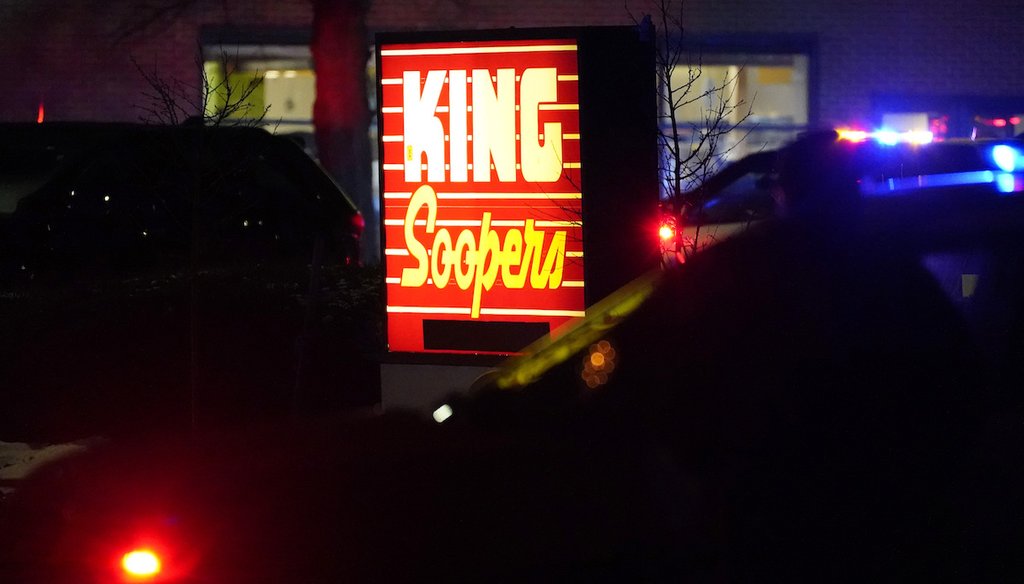Stand up for the facts!
Our only agenda is to publish the truth so you can be an informed participant in democracy.
We need your help.
I would like to contribute

Police stand guard outside a King Soopers grocery store after a shooting, on March 22, 2021, in Boulder, Colo. (AP/Zalubowski)
Fact-checking Joy Behar on mass shootings and the assault weapons ban
If Your Time is short
-
A federal ban on assault weapons expired in 2004 because of a sunset provision written into the law. President George W. Bush didn’t lift it.
-
Growing evidence suggests that deadly mass shootings rose after the ban expired. Proving cause-and-effect is difficult.
After a Colorado gunman killed 10 people in what was the second mass shooting in a week, Democrats and gun control advocates renewed calls for a nationwide ban on assault weapons, like the federal law that was in effect from 1994 until 2004.
Joy Behar, co-host of ABC’s "The View," joined the chorus March 23.
"In 2004, George W. Bush lifted the ban on those rifles, and since then, the number of massacres has increased 183%," Behar said, after rattling off a list of high-profile mass shootings from recent years where the perpetrators used AR-15 style weapons.
"During the ban, there were 12 incidents," Behar continued. "Since he lifted the ban, there were 34 incidents. Anybody, or a right-minded person, can see that that gun has to go."
PolitiFact has fact-checked similar claims assessing the impact of the 1994 assault-weapons ban several times following other mass shootings. We wondered if Behar’s statement was true.
The first part of her statement was not. The 1994 ban enacted under former President Bill Clinton expired because of a sunset provision written into the law, not because Bush decided to axe it, as Behar claimed. News reports from the time said he was on board with renewing it.
But on the second part, we found that Behar’s numbers aligned with at least one researcher’s findings on mass shootings during and after the ban. And experts who study mass shootings said her broader point — that the number of high-fatality incidents has increased since the ban went away — is largely accurate, although proving cause-and-effect is difficult.
The 1994 ban had a sunset provision
The 1994 law, part of an anticrime package authored by then-Sen. Joe Biden, banned the "manufacture, transfer and possession" of certain semiautomatic firearms classified as "assault weapons" as well as certain high-capacity ammunition magazines of more than 10 rounds.
Clinton signed the law, and Bush was in office when it expired. But Bush didn’t scrap the law.
"It had a sunset provision and would end after 10 years without renewal or reinstatement," said Adam Lankford, a professor of criminology and criminal justice at the University of Alabama.
News accounts from the time indicated that as Congress considered extending the ban beyond 2004, Bush said he would support doing so.
"There were attempts by members of Congress to reauthorize it, including Dianne Feinstein, and they all failed," said Jaclyn Schildkraut, associate professor of criminal justice at the State University of New York at Oswego. "But it was not George Bush who lifted it."
Behar’s numbers line up with one study
There’s no universally accepted definition for mass shootings or "massacres," as Behar described the incidents in question.
Asked where Behar got her numbers, an ABC spokesperson pointed to a 2018 report in the Washington Post. The report documented the findings that Louis Klarevas, research professor at Teachers College, Columbia University, outlined in his 2016 book, "Rampage Nation."
Klarevas examined incidents over three decades — before, during and after the 1994 ban — in which six or more people were shot and killed, not including the perpetrators.
His findings shook out this way:
-
The decade before the ban, 1984-94: 19 incidents.
-
The decade during the ban, 1994-04: 12 incidents.
-
The decade after the ban sunset, 2004-14: 34 incidents.
That shows a 183% increase from the decade during the ban to the decade after it ended. Klarevas told PolitiFact that Behar’s claim was largely accurate, save for the blame she wrongly heaped on Bush — and one other caveat.
The research Behar cited "does not account for all high-fatality mass shootings since the federal ban expired," Klarevas said. It accounts for only the first 10 years after the ban.
"Behar actually understated the raw numbers, because she said 34 incidents ‘since’ the ban was ended," Lankford said.
Klarevas said that since the ban expired, he has counted 62 incidents in which six or more people were shot and killed, including the recent shootings in Atlanta and Boulder, Colo.
"To put this in perspective, during the decade of the federal assault weapons ban, there were 12 high-fatality mass shootings. That comes out to an average of 1.2 incidents per year," Klarevas said. "In the 16.5 years since the expiration of the federal ban, there have been 62 high-fatality mass shootings. That comes out to an average of 3.8 incidents per year."
Between the ban’s expiration and the end of 2019, 32% of high-fatality mass shootings Klarevas recorded involved firearms classified as assault weapons, and 82% involved large-capacity magazines, he said.
Other related studies
Other research backs Behar’s broader point that mass shootings have gone up since the ban ended. Not all mass shootings are carried out with the style of weapons that were banned.
Schildkraut’s research follows a different definition of mass shootings that counts targeted, public shootings in which "multiple" victims are injured or killed within 24 hours. By her definition, which doesn’t count shootings related to gang violence or terroristic activity, there were 13 mass shootings involving an assault weapon during the ban, and 27 in the decade after.
"We used a different definition of public mass shootings, but our numbers are similar," she said.
Grant Duwe, director of research and evaluation for the Minnesota Department of Corrections, who defines mass shootings as incidents where four or more victims are publicly killed, told the Washington Post that his numbers show "there has been an increase in both the incidence and severity of mass public shootings (on a per capita basis) since the latter part of the 2000s."
Other recent research came from Christopher Koper, a George Mason University professor who wrote a 2004 Justice Department study that gave fuel to both sides of the gun control debate.
In a 2020 report, Koper said the ban on assault weapons and large-capacity magazines "had exemptions and loopholes that limited its short-term effects, but its expiration in 2004 was followed by an increase in the use of these weapons in mass shootings and other crimes."
Research Lankford co-authored found that attackers’ increased use of semi-automatic rifles and assault weapons is part of the reason why the U.S. has had more high-fatality shootings over time. Another reason appears to be "a change in motives" that has more recent mass shooters seeking to kill large numbers of people for fame and attention, Lankford said.
In previous fact-checks, experts cautioned that it's difficult to directly tie increases in mass shootings to the expiration of the 2004 ban.
Klarevas, for his part, argued that the data are strong enough to suggest a causal relationship. A 2019 study that he co-authored, which focused on large-capacity magazines, "suggested that bans on large-capacity magazines were effective at reducing mass shooting violence," he said.
Our ruling
Behar said, "In 2004, George W. Bush lifted the ban on those (AR-15 type) rifles, and since then, the number of massacres has increased 183%. During the ban, there were 12 incidents. Since he lifted the ban, there were 34 incidents."
The ban expired because of a sunset provision in the law, not because of Bush.
The numbers in Behar’s claim aligned with — and even understated — one researcher’s findings on the number of mass shootings that occurred during and after the 1994-to-2004 ban. Other research has similarly identified increases in such incidents since the ban ended, though the exact numbers vary partly due to how "mass shooting" is defined.
We rate this claim Half True.
Our Sources
ABC, "The View," March 23, 2021
The Washington Post, "Biden’s claim that the 1994 assault-weapons law ‘brought down’ mass shootings," March 24, 2021
Criminology & Public Policy, "Assessing the potential to reduce deaths and injuries from mass shootings through restrictions on assault weapons and other high-capacity semiautomatic firearms," 2020
The American Journal of Public Health, "The Effect of Large-Capacity Magazine Bans on High-Fatality Mass Shootings, 1990–2017," December 2019
Criminology & Public Policy, "Why have public mass shootings become more deadly?: Assessing how perpetrators’ motives and methods have changed over time," December 2019
SUNY Rockefeller Institute of Government, "Assault Weapons, Mass Shootings, and Options for Lawmakers," March 22, 2019
The Washington Post, "Bill Clinton’s claim that the assault weapons ban led to ‘a big drop in mass shooting deaths,'" Aug. 18, 2019
The Washington Post, "It’s time to bring back the assault weapons ban, gun violence experts say," Feb. 15, 2018
The Los Angeles Times, "Assault Weapons Ban Ends Quietly," Sept. 10, 2004
The Associated Press, "Congress lets assault weapons ban expire," Sept. 8, 2004
U.S. Justice Department, "Updated Assessment of the Federal Assault Weapons Ban: Impacts on Gun Markets and Gun Violence, 1994-2003," July 2004
Government Publishing Office, "Violent Crime Control and Law Enforcement Act of 1994," Jan. 25, 1994
PolitiFact, "AR-15 style weapons were used in 10 major shootings," March 24, 2021
PolitiFact, "Did mass shooting deaths fall under the 1994 assault weapon ban? Checking Bill Clinton's claim," Aug. 7, 2019
PolitiFact, "Did mass shootings increase 200 percent since assault weapons ban expired?" Feb. 23, 2018
Email interview with Lauri Hogan, publicity director for ABC Television Network, March 23, 2021
Email interview with Jaclyn Schildkraut, associate professor of criminal justice at the State University of New York at Oswego, March 23, 2021
Email interview with Louis Klarevas, research professor at Teachers College, Columbia University, March 23, 2021
Email interview with Adam Lankford, professor of criminology and criminal justice at the University of Alabama, March 23, 2021
Browse the Truth-O-Meter
More by Bill McCarthy
Fact-checking Joy Behar on mass shootings and the assault weapons ban
Support independent fact-checking.
Become a member!
In a world of wild talk and fake news, help us stand up for the facts.






























